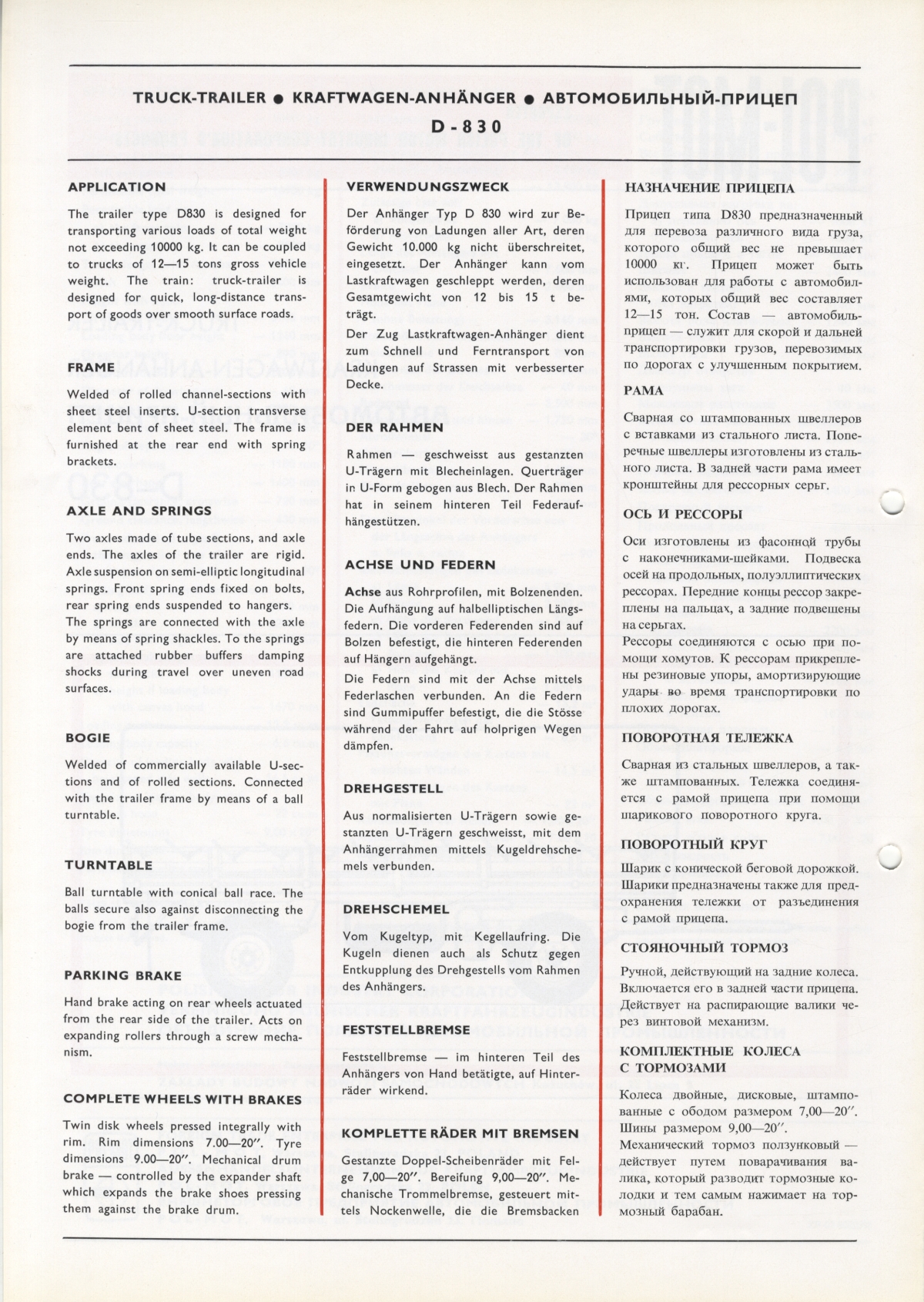df pro a�01667�6�2

TRUCK-TRAILER • KRAFTWAGEN-AN HANGER • ABTOMOEMJIbHblM-nPMMEn
D - 8 3 0
APPLICATION
The trailer type D830 is designed for transporting various loads of total weight not exceeding 10000 kg. It can be coupled to trucks of 12—15 tons gross vehicle weight. The train: truck-trailer is
designed for quick, long-distance transport of goods over smooth surface roads.
FRAME
Welded of rolled channel-sections with sheet Steel inserts. U-section transverse element bent of sheet Steel. The frame is furnished at the rear end with spring brackets.
AXLE AND SPRINGS
Two axles madę of tubę sections, and axle ends. The axles of the trailer are rigid. Axle suspension on semi-elliptic longitudinal springs. Front spring ends fixed on bolts, rear spring ends suspended to hangers. The springs are connected with the axle by means of spring shackles. To the springs are attached rubber buffers damping shocks during travel over uneven road surfaces.
BOGIE
Welded of commercially available U-sec-tions and of rolled sections. Connected with the trailer frame by means of a bali turntable.
TURNTABLE
Bali turntable with conical bali race. The balls secure also against disconnecting the bogie from the trailer frame.
PARKING BRAKE
Hand brake acting on rear wheels actuated from the rear side of the trailer. Acts on expanding rollers through a screw mecha-nism.
COMPLETE WHEELS WITH BRAKES
Twin disk wheels pressed integrally with rim. Rim dimensions 7.00—20". Tyre dimensions 9.00—20". Mechanical drum brake — controlled by the expander shaft which expands the brake shoes pressing them against the brake drum.
YERWENDUNGSZWECK
Der Anhanger Typ D 830 wird zur Be-fórderung von Ladungen aller Art, dereń Gewicht 10.000 kg nicht iiberschreitet, eingesetzt. Der Anhanger kann vom Lastkraftwagen geschleppt werden, dereń Gesamtgewicht von 12 bis 15 t be-tragt.
Der Zug Lastkraftwagen-Anhanger dient zum Schnell und Ferntransport von Ladungen auf Strassen mit verbesserter Decke.
DER RA HM EN
Rahmen — geschweisst aus gestanzten U-Tragern mit Blecheinlagen. Quertrager in U-Form gebogen aus Blech. Der Rahmen hat in seinem hinteren Teil Federauf-hangestiitzen.
ACHSE UND FEDERN
Achse aus Rohrprofilen, mit Bolzenenden. Die Aufhangung auf halbelliptischen Langs-federn. Die vorderen Federenden sind auf Bolzen befestigt, die hinteren Federenden auf Hangern aufgehangt.
Die Federn sind mit der Achse mittels Federlaschen verbunden. An die Federn sind Gummipuffer befestigt, die die Stósse wahrend der Fahrt auf holprigen Wegen dampfen.
DREHGESTELL
Aus normalisierten U-Tragern sowie gestanzten U-Tragern geschweisst, mit dem Anhangerrahmen mittels Kugeldrehsche-mels verbunden.
DREHSCHEMEL
Vom Kugeltyp, mit Kegellaufring. Die Kugeln dienen auch ais Schutz gegen Entkupplung des Drehgestells vom Rahmen des Anhangers.
FESTSTELLBREMSE
Feststellbremse — im hinteren Teil des Anhangers von Hand betatigte, auf Hinter-rader wirkend.
KOMPLETTE RADER MIT BREMSEN
Gestanzte Doppel-Scheibenrader mit Fel-ge 7,00—20". Bereifung 9,00—20". Me-chanische Trommelbremse, gesteuert mittels Nockenwelle, die die Bremsbacken
HA3HAHEHHE TIPHUEIIA
ripnuen Twna D830 npeAHasHaHeinibitt A/ia nepcBo3a paijiHMiioro Bwaa rpyia, KOToporo o6mnft bcc He npeBbiuiacT I0000 ki. ripHuen Moacer 6biTb
HCnOJlblOBaH JWH paÓOTbl C aBTOMo6HJl-flMH, KOTOpbIX o6mwR BCC COCTaBJlHCT
12—15 TOH. CoCTaB aBTOMo6HJTb-
npnuen — cnyjKHT ajih CKopoft h /uuibucH TpaucnopTHpoBKH rpy30B, nepeB03HMbix no ,aoporax c y/iyHuieHHbiM noKpbiTHeM.
PAMA
CBapiraa co iuTaMnoBaimbix uiBejiaepoB C BCTaBKaMH H3 CTa/IbHOro JlHCTa. rionc-pCHHbie UiBeJlJiepbl H3rOTOB/ICHbl H3 CTa/Ib-noro JiHCTa. B 3aAHeił nacm pa\ia HMeeT KpoHiHTeHHbi ann peccopHbix cepbr.
OCb M PECCOPbl
Och H3roTOBJieHbi H3 (|)acoHHc^i Tpy6bi c HaKOHeHHHKaMH-meHKaMH. rioflBecKa oceft Ha npoaoJibHbix, iioJiy3;uiHnTHHecKHx peccopax. riepeanne KOHUbi peccop 3axpe-njiCHbi Ha najibuax, a 3aflime no^BcmeHbi na cepbrax.
Peccopbi coeaHHflioTCH c ocbK) npw no-moihh xoMyTOB. K peccopaM npuKpciuie-Hbl pC3HlfOBbie ynopbl, aMOpTH3HpyiOlHHC yflapw bo Bpe\iH TpaircnopTHpoBKK no n;ioxKx ,noporax.
IIOBOPOTHAB TEJ1E)KKA
CBapHaa H3 CTajibHbix uiBennepoB, a Tax-Hcc HiTaMnoBaHHbix. TejiejKKa coeaHHH-eTca c paMoił npwuena npn noMoum uiapuKOBoro noBopoTHoro Kpyra.
riOBOPOTHbiM Kpyr
lllapnK c KoiniHCCKoil 6croBoR ^opoacKoił. lllapHKH npeaHa3HaHeitbi TaK>xc ajih npca-OXpaHCHKfl TeJie)KKK OT pa3T>eAHHeHH« c paMOH npHnena.
CTO»HOHHblfl T0PM03
PyHHoft, actfcTByioiHMH na 3aAHne KOJieca. BKJiioHaeTca ero b 3aaneH nacTH npHnena. /JeftcTByeT Ha pacoKpaiomwe Ba;iHKH ne-pe3 BHHTOBOft MCXaHH3M.
KOM1 IJlEKTHblE KOJIECA C T0PM03AMM
Koneca flBoftubic, jwcKOBbie, ujTaMiio-BaHHbie c o6o,aoM pa3MepoM 7,00—20". lllHHbt pa3MepOM 9,00—20". Mexainf4ecKHft topmo3 noJi3yHKOBbiJł — ^ewcTByeT nyTeM noBapanuBaiiHa Ba-JIHKa, KOTOpblH pa3BOAKT TOpM03Hbie KO-JIO/IKH H TeM CaMbLM Ha>KHMaeT Ha TOp-M03HbiH 6apa6aH.
Wyszukiwarka
Podobne podstrony:
df pro a�01667�1�2 SPRINKLING-SWEEPING-FLUSHING TRUCK •
df pro a�01667�1�3 The PZ6 sprinkler truck is manufactured in several versions according to the type
df pro a�01667�1�4 Lubrication system capacity (1) — 8 Oil amount in the gearbox (1) — 5 Oil amoun
df pro a�01667�1�5 Kind of finał drive — bevle Overall ratio of the finał drive — 7.17 Frame — welde
df pro a�01667�1�6 THIS IS A TEMPORARY EDITIO N ERSATZAUSGABE H3AAHHE BPEMEHHOE The right to in
df pro a�01667�2�2 AGRICULTURAL TRAILER • LANDWIRTSCHAFTLICHER ANHANGER • CE/lbCKOXO- 3RMCTBEHHbm RP
df pro a�01667�2�3 — 2 — 2 — 10—15" — flachę — 9—15 de
df pro a�01667�2�4 — 990 kg — 3500 kg — 4490 kg — 3,53 — 3a
df pro a�01667�2 POLISH MOTOR INDUSTRY CORPORATION YEREINIGUNG POLNISCHER KRAFTFAHRZEUGINDUSTRIE OET
df pro a�01667�3�1 EXPORTER OF THE POUSH MOTOR INDUSTRY CORPORATION^ PRODUCTS AGRICULTURAL TIPPER TR
df pro a�01667�3�2 AGRICULTURAL TIPPER TRAILER • LANDWIRTSCHAFTLICHER KIPPER-ANHANGER CEJlbCK0X03Rki
df pro a�01667�3�3 BRAKES Type of main brake — pneumatic, over- pressure, single--line, acting on al
df pro a�01667�3�4 WEIGHTS Unladen weight Load capacity Permissible total weight Load fact
df pro a�01667�4�2 TRUCK TRAILER • KRAFTWAGEN-ANHANGER • ABTOMOEM/lbHbm nPMUEnD-50APPLICATION The tr
df pro a�01667�4�3 BRAKES a) Air-pressure main brake system furni-shed with coupling for connecting
df pro a�01667�4�4 — seven-pin plug-im sockets for connect-ing the trailer to anot
df pro a�01667�5�2 TIPPING TRAILER • AN HANGER-KIPPER • riPM UEri-CAMOCBAJlD-AOAPPLICATION The tippi
df pro a�01667�5�3 Mhcjio kojicc: nepcjiHHx 3aAHHX Pa3MepbI LLIHH Pa3Mcpbi o6oaa KOJieca M
df pro a�01667�5�4 — geschweisst — 2600 mm — 1800 mm — Ohr 0 76
więcej podobnych podstron